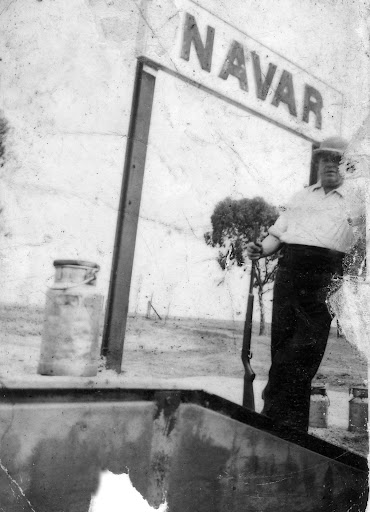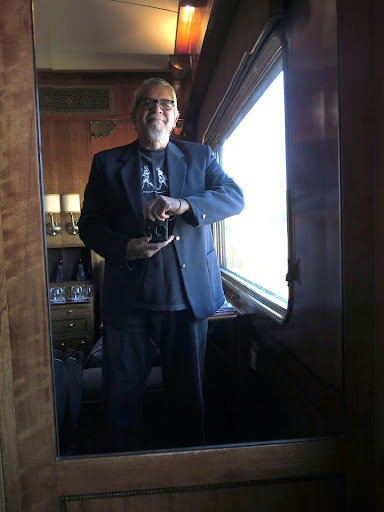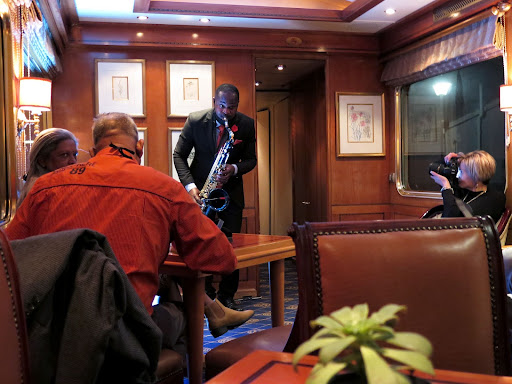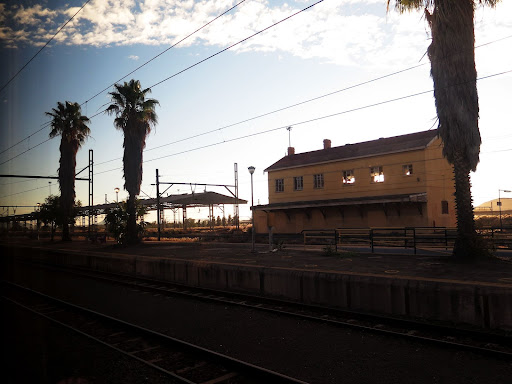Making tracks: The Blue Train, which is kept in mint condition, has a luxurious observation area, from which to watch the passing scenery. (Photos: Rafs Mayet)
Among the photo albums that became mine after my dad’s death was a tiny picture of a middle-aged man on a station platform holding a rifle and standing next to a milk churn. Behind what seems to be a pith helmet on his head is a sign that says “Navar”, which is a town near Elliot in the Eastern Cape. On the back of the photograph in my dad’s beautiful writing is “Joe Mayet, my father, who was postmaster and station master of Navar” next to a post office stamp with the date 19 September 1939.
Grandpa Joe was a bit of a wag (according to family legend). He left the planet before I arrived so I never knew him. There are other photos of him — on a camel with the pyramids in the background, on horseback at some diamond diggings in Kimberley and others. He and his brother had a great time early in the last century wasting the then-considerable family fortune on “fast women and slow horses”, as my father put it.
I think I inherited his itchy feet because I’ve been travelling on trains for a long time.
 Long journey: A photograph of Joe Mayet, who was a station master at Navar, in what is now the Eastern Cape. (Courtesy of Rafs Mayet)
Long journey: A photograph of Joe Mayet, who was a station master at Navar, in what is now the Eastern Cape. (Courtesy of Rafs Mayet)
From early trips with my mom and sister to Jozi every winter, I’ve been fortunate to travel on all kinds of trains both at home and abroad. First, second and third class, premier class, the Shosholoza Meyl, the Drakensberg Express, the Orange Express, the Heathrow Express from Paddington. I’ve even been on a double decker train in the Netherlands and spent 39 days on something called The Climate Train (a project of the parastatal Indalo Yethu that criss-crossed South Africa during the COP17 conference of 2012, bringing schoolchildren to this specially equipped train for environmental education).
While working out of Beaufort West station, the Blue Train came past and we watched enviously as the passengers enjoyed what looked like high tea in the observation car at the back of the train.
A few years later I was lucky enough to take a journey on the very same Blue Train from Cape Town to Tshwane and it was all it promised to be and more. The indulgence started at the Blue Train station lounge in Cape Town where, after checking in and doing a Covid test, guests were welcomed with a small talk about house rules by the train manager, Amos Mbambo, and treated to pre-departure drinks and canapés.
We were then escorted on board to our suites by our own personal butlers, who explained how things worked. By 2pm we were on our way, locked in this mobile luxury capsule for the next 1 600 kilometres with one stop in Kimberley.
I always have a sense of expectation and purpose when departing for a destination. For me, it seems there’s some kind of achievement when movement and direction combine. This trip was no different.
The first thing I did was to sit in the observation car while we slid out of the city past the suburbs and townships, heading off in a north-easterly direction towards the Highveld.
Coming down from Gauteng (usually on the Shosholoza Meyl), I always enjoy coming through the Hex River Valley by day where the road, the railway line and the river run parallel to each other, and then into Touwsrivier, meandering through the winelands to the Mother City.
But, because of delays for various reasons (like a 40-minute wait for a broken-down train in Bellville), this wasn’t possible. It was dark by the time we got there, but it didn’t matter because the eating had begun on this five-star mobile hotel. There’s afternoon tea from 4pm and then the first of two dinner sittings at 6.30pm and the second at 8.15pm.
The 39 passengers on this trip (the train set can host up to 54 people, with train set two holding up to 88), were pampered by 23 staff members. There are three hot chefs, three cold chefs and a sculler to provide a five-course menu that includes vegetarian and vegan meals. Passengers are required to dress formally for dinner (coat or tie or both), a throwback to a more elegant, graceful time. I’ve hardly worn either since finishing high school many moons ago.
 A self-portrait of the writer in his mandatory Blue Train dinner gear.
A self-portrait of the writer in his mandatory Blue Train dinner gear.
A few days before the trip, and after getting my first Covid jab, I walked past a small charity shop near the Athlone Stadium, where I found a cool blazer that felt good on me. R30 later, it was mine, along with a tie that cost R5. And this was how I spent the next two evenings — good food, coffee and cigars in the cigar lounge and then back to my deluxe suite with the bed covers turned down and some chocolates on the pillow, a little light reading and then off to dreamland.
There’s a small TV above the armoire and although it cannot show live programmes (because of interference from the overhead power lines), there’s a fairly large selection of films and music. I was pleasantly surprised with the inclusion of the music of the African Jazz Pioneers, Marcus Wyatt and other local artists.
I did manage to re-read The Great Railway Bazaar by Paul Theroux but, unlike myself, he had only one really luxurious trip among many interesting but difficult ones during his sojourn across Europe and the Far East. Published in 1976, it is more about the quirky characters that he met and his experiences with them.
Every journey throws together strange characters. Some oddballs I have met on my travels included one guy who climbed on board a train with a 25 litre container of “homebrew” that he had made himself before leaving that very morning. Every now and then the lid would shoot off as pressure built up ‘cos it was still fermenting. Then he’d lean over, refill his glass, replace the lid and continue with his conversation.
Another dude travelling from Jozi to Standerton claimed he was the fire-punching champion of the world. When asked to elaborate, he pulled out a scrapbook with articles from local knock-and-drops like the Boksburg Clarion and the Benoni Times. It seems that at community charity events, he would stand in front of a braai fire and punch the fire for as long as he could stand it. Not sure why he did this because his hands were covered in scar tissue and burn marks. These were just a few that I came across. I’d try to get on board early, claim the top bunk and settle in to read or listen to the others’ conversations.
On the Blue Train, I sometimes eavesdropped on my fellow travellers, listening to the accents (French, American and German, as well as the local ones) of the mostly middle-aged couples.
The same two ladies who did the Covid testing at the reception lounge were also on board the train, visiting every day to check our temperatures and so on.
As with every trip, there is bound to be at least one difficult character. This one in particular, on the second evening, sent his steak back and complained about ginger in the soup and other things. The serving staff coddled him a bit, and after a little more wine he soon stopped his moaning.
 Bandleader Femi Koya, on Blue Train trips since 2019, knows the difference between entertainment and performance.
Bandleader Femi Koya, on Blue Train trips since 2019, knows the difference between entertainment and performance.
I watched as the servers worked as a team, dancing around and helping each other, making for a pleasant experience at all mealtimes on this movable culinary feast. There was also live music for diners, provided by saxophonist Femi Koya, who has been on train trips since 2019, entertaining diners during meals. He has about four or five albums out and also plays with his own group on weekends at a Sandton hotel.
Despite coming from a highlife and Afro-pop background, he’s quite clear about the difference between performance and entertainment, giving the punters what they want — music to munch by, nothing too adventurous or challenging — while watching the ever-changing scenery.
There’s a warm, amber glow from the birchwood veneers both in the suites and in the passages of the coaches and this décor is maintained throughout with various artworks on display. I saw a woodcut by Dan Rakgoathe near the observation car and several botanical prints in the lounge and dining area.
The cigar lounge at the other end of the train was popular after meals. It reinforces the luxury of the trip with everything included in the price of a ticket. The only other things one would pay for is caviar, French champagne and external phone calls.
The viewing car is where I watched the sun rise on both mornings. This carriage, with double-glazed windows on three sides, also offers coffee and nibbles such as fruit, nuts, biltong, all served from a little room at the back of the coach. There’s also a souvenir shop, where people can buy mementoes of their trip. And you can get a certificate and a clock as a gift of remembrance of your time spent on one of the most luxurious train trips in the world.
 The only stop on the 1600 kilometre Blue Train ride, the Railway Museum is not too far from the Kimberley platform.
The only stop on the 1600 kilometre Blue Train ride, the Railway Museum is not too far from the Kimberley platform.
The only place where one gets out of this cocoon is at Kimberley for an excursion to the Big Hole. Passengers are taken to the old diamond diggings and a tour of the museum there. But first there was a short visit to the Railway Museum on the Kimberley platform, where various railway artefacts were on display.
But the highlight for me was finding posters of poems about trains that were written by people like Mafika Gwala, Totius, Christopher Hope, Mothobi Mutloatse, Ernst van Heerden, Alan Paton, Dennis Brutus and others. So I wandered around the station pretty much by myself, because I had already seen the Big Hole a long time ago. (One passenger remarked that he had already seen a few “Groot Gatte” in his time).
As memorable as the journey was, I thought about a few things. Like how come in this truly beautiful country of ours, we don’t have too many landscape photographers and artists despite the stunning vistas that regularly flashed past us, from the changing vegetation of the winelands through the arid scenes of the Karoo desert and all the way up to the Highveld.
It was disturbing to see kilometres of shacks outside Warrenton, just a few metres away from the tracks. I could see people preparing their evening meal while I was having a biccy or two in the viewing car. While we were stuffing ourselves on a mobile feast, just a few metres away hungry folks were watching our indulgence.
The devastation and destruction of a once vibrant and productive railway system was emphasised by what I saw. There are whole stations that have been stripped and now look like sets from a ghost town movie. Everything that wasn’t locked down has been removed.
 Once a bustling junction, the De Aar station is now the epitome of dereliction, a scene that reappeared throughout parts of the journey from Cape Town to “Peeraks”
Once a bustling junction, the De Aar station is now the epitome of dereliction, a scene that reappeared throughout parts of the journey from Cape Town to “Peeraks”
So, beside the usual cable theft, there are empty shells of buildings, broken windows, grass and other undergrowth that is head-high. It was disheartening to see the once bustling junction of De Aar, where trains from all over the country used to arrive and depart for other destinations, is now derelict and abandoned.
This pattern of wanton and seemingly senseless breaking down of a working environment was repeated all the way to Tshwane. The stealing of cables and other parts of stations, the sales to scrap yards that in turn sell it on to overseas buyers, the lack of convictions, the impunity of all involved just reinforced the view that someone higher up has vested interests in trucking and other modes of transporting goods around the country. Else how and why is a working system allowed to deteriorate so extensively?
The railways can really help to boost our economy, save our roads from relentless use by heavy mechanical monsters and provide jobs for many. Although it provided sheltered employment for some sectors in the past, there must surely be some role for it to play in the present and the future.
The ever-widening chasm of our unequal society is reinforced by the prevalence of poverty. A long time ago, I travelled on the “milk train”. It was a super-slow trip (more than 24 hours) to Durban and the train called in at every little siding and station on the way, dropping off and picking up the mail and milk churns like the ones in the photo of my Grandpa Joe. There was obvious pride in many of the stations. Small, colourful gardens out front and often an economic hub for residents, because people were transported from there and goods were delivered almost to your doorstep by trains.
So, as great a time as I had on the luxuriant, world-famous Blue Train, there were some worries. It did not stop me from thinking about songs about trains. Hear My Train A Comin’ by Jimi Hendrix. People Get Ready by Curtis Mayfield. It Takes a Lot to Laugh, It Takes a Train to Cry and Slow Train Coming by Bob Dylan. Long Train Running by the Doobie Brothers and many more.
The obvious South African song is Stimela from Bra Hugh Masekela. Then there’s Kushu Kushu by Welcome Duru. My favourite is Mbombela by Bayete, mainly because I was around when they were recording it. And so we came to the end of our journey in Tshwane, or Peeraks as the locals call it. The warmth of the Blue Train was replaced with the cold, clinical, characterless and efficient reality of the Gautrain.
Now for Amtrak or even the bullet trains of Japan. One can but dream, hey?
For more information on trips and prices, please visit bluetrain.co.za